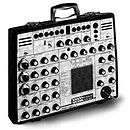Electronic Music Studios
Electronic Music Studios (London) Ltd. (usually abbreviated to EMS) is a synthesizer company formed in 1969 by Peter Zinovieff, Tristram Cary and David Cockerell.
The partners had wide experience in both electronics and music. Cockerell, who was EMS' main equipment designer in its early years, was a gifted electronics engineer and computer programmer. In the mid-1960s Zinovieff (who originally qualified as a geologist) had formed the pioneering electronic music group Unit Delta Plus with Delia Derbyshire and Brian Hodgson of the BBC Radiophonic Workshop. Cary was a noted composer and a pioneer in electronic music—he was one of the first people in the UK to work in the musique concrete field and built one of the country's first electronic music studios; he also worked widely in film and TV, composing scores for numerous Ealing Studios and Hammer Films productions, and is he well known for his work on the BBC's Doctor Who, notably on the classic serial The Daleks.
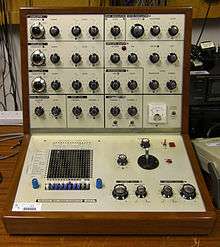
VCS 3
The company's first commercial synthesiser, the VCS 3 (or VCS3), designed by David Cockerell, was produced in 1969. It was developed in the basement of Zinovieff's house and was nicknamed "The Putney" after the London suburb where he was living at the time.[1][2]
EMS' original aim was to create a versatile monophonic synthesiser that would retail for just £100. While this proved unattainable in practice, the company nevertheless succeeded in manufacturing the VCS3 for just £330, less than its nearest American competitor the Minimoog (which originally retailed for US$1495 when released in 1970) and far cheaper than Moog's modular systems, which cost tens of thousands of dollars. EMS also released the DK1, a velocity sensitive dynamic monophonic keyboard controller for use with VCS3; this included an extra VCO and VCA and retailed for £145. [3][4][5] The DK1 was nicknamed "The Cricklewood" after the London suburb where Cockerell lived. EMS used to have a R&D department based over a DIY shop in Cricklewood Lane, Cricklewood, London, so that could have influenced the name of the mechanical keyboard. It is not widely known that EMS electronic equipment was mostly made by another company "Hinton Electronics" based in Wareham, Dorset.
The VCS3 consisted of 3 voltage-controlled oscillators (VCOs), a noise generator, two input amplifiers, ring modulator, voltage-controlled low-pass filter, trapezoid envelope generator, voltage-controlled reverberation, level meter, two output amplifiers thus providing a stereo output, and a joystick providing 'X' and 'Y' modulation control.
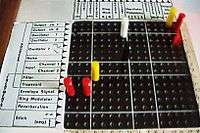
A distinctive design feature of the VCS3 (and later EMS systems) was that, rather than using patch cords to route audio and control signals between modules, Cockerell employed a small matrix plugboard into which the user stuck special conductive pins that connected an input (listed on the X-axis of the matrix) to an output (on the Y-axis). This matrix patchboard gave the VCS3 a high degree of inter-connectivity, comparable to that of much larger modular systems, and far greater than similar small synthesisers like the Minimoog. It was also much easier to examine than the tangle of patch cords used to interconnect other modular systems of the day, such as the Moog modular synthesizer and was many times smaller than the cumbersome Moog patch bays, which used patch cord leads capped with 1/4-inch 'phone' jacks.
A live performance version, the VCS4, was built later the same year but was never put into production. It comprised two VCS3s side-by-side with a keyboard, mixer and signal processing in front, all in a single wooden cabinet. Although EMS lost track of the instrument in 1983, it has survived and at last report was known to be in the United States.[6]
The company's next project, the Synthi KB1 (1970), designed by Cockerell, also never went into production. It featured the same synthesis modules as the VCS3, but housed in a horizontal box casing, with a 29-note mini-keyboard controller and two small built in speakers. Only one prototype unit was built and this was subsequently sold to the progressive rock group Yes. [7]
Synthi 100

EMS moved into direct competition with Moog in 1971 with the development of its first large-scale modular synthesiser, the "Synthi 100", which originally retailed for £6,500. This unit was first known as the "Digitana" but was later dubbed "The Delaware", after Delaware Rd, Maida Vale, the location of the BBC Radiophonic Workshop. This system, mounted in a free-standing console cabinet, used the same technology as the VCS3, being in essence three VCS3 units combined. It was driven by twelve VCOs and featured a built-in oscilloscope, two 60 x 60 patchbays, two joystick controllers, dual five-octave velocity-sensitive keyboard controllers and a 3-track, 256-step digital sequencer. Between 30 and 40 units were built, and these enjoyed wide use in the 1970s and beyond; one model was sold to the BBC Radiophonic Workshop and was used extensively on BBC productions including Doctor Who, Blake's 7 and the original radio version of The Hitchhikers' Guide to the Galaxy. The sequencer module of the Synthi 100 was also made available as a separate unit, the Synthi Sequencer 256, which originally retailed for £1,100.[8]
Synthi A / Synthi AK / Synthi AKS
.jpg)
During 1971 EMS released a portable version of the VCS3, the EMS Synthi A, originally called the "Portabella", a pun on London's Portobello Road. Built into a compact Spartanite attaché case, this unit was even cheaper than the original VCS3 and retailed for just £198. The following year EMS released an expanded version, the Synthi AKS, which retailed for £420 and featured a sequencer and a small keyboard built into the lid. The first 30 AK units featured a black and silver touch pad, a Spin-and-touch random note selector and a resistive touch-sensitive keyboard; these original keyboards proved difficult to use, so they were subsequently replaced with the more familiar blue capacitive touch sensitive keyboard with integrated sequencer, and became known as the KS version.[9]
The Synthi AKS proved very popular and AKS units owned by Eno, Pink Floyd and Jean-Michel Jarre featured prominently in music by these artists in the early 1970s; one of the best-known appearances of an AKS on record is the track "On the Run" from Pink Floyd's The Dark Side of the Moon (1973), and it can be seen being used by Roger Waters and David Gilmour during the recording of the album in footage included both the 1st Director's Cut of Live at Pompeii and in the DSOTM episode of the BBC documentary series Classic Albums respectively (Gilmour used his to demonstrate the sequence used in the song).
EMS Synthesisers in music and the media
EMS synthesisers and their London studios were used by many prominent rock and electronic artists including Pink Floyd (Meddle, Obscured by Clouds, Dark Side of the Moon, Animals, Wish You Were Here), The Who (Won't Get Fooled Again), BBC Radiophonic Workshop, Brian Eno and Roxy Music, Tangerine Dream (all early albums), Hawkwind, Tim Blake, Jean Michel Jarre and Kraftwerk and David Vorhaus (White Noise 2). As noted above, the Synthi 100 "Delaware" owned by the Radiophonic Workshop was used extensively for BBC radio and television productions in the 1970s.
The EMS Synthi Hi-Fli was used extensively by Tony TS Mcphee of The Groundhogs and was used on the album SOLID in 1974. Footage exists of them live at the MARQUEE CLUB in London and it is clearly visible on its stand on stage. This footage was broadcast on The Old Grey Whistle Test in '74. YouTube has one clip:Groundhogs Light My Light 1974 (video).

In late 2010 Dr. Zinovieff put his original Synthi A synthesiser (serial number 4016) up for sale. This instrument, which he believes was the one featured in the "Every Picnic Needs a Synthi" press advertisement,[10] was fully restored by Robin Wood at EMS.[11]
EMS equipment can be seen in the 1978 British horror film The Shout starring Alan Bates, John Hurt and Susannah York, the equipment featured includes a Synthi Sequencer 256, a Vocoder 2000 and a VCS3, the film is available on DVD (Network 79527630), the equipment was loaned to "The Rank Organisation" by Dartington College in Devon, and the featured Synthi Sequencer 256 was recently sold on the "Vintage Electronic Musical Instrument Auction" VEMIA [12] website in April 2011.
Timeline of major products
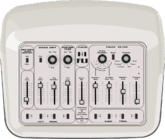

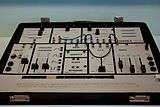
- 1969 - EMS VCS 3
- 1971 - EMS Synthi A
- 1971 - EMS Synthi AK
- 1971 - EMS Synthi 100
- 1971 - EMS Synthi Sequencer 256 (digital sequencer) [13]
- 1972 - EMS Synthi AKS
- 1973 - EMS Synthi Hi-Fli (multi-effect type guitar synthesizer) [14]
- 1974 - EMS Spectron (video synthesizer) [15][16]
- 1975 - EMS Synthi E [17]
- 1976 - EMS Vocoder 5000 [18]
- 1977 - EMS Vocoder 2000 [19]
- 1978 - EMS PolySynthi (polyphonic synthesizer) [20]
References
- Hinton, Graham (2002-12-27). "EMS: The Inside Story". Cornwall: Electronic Music Studios. Archived from the original on 2013-05-21.
Inside story about the beginnings of EMS, studios, non commercial equipments, peoples and users. - Hinton, Graham (2001-06-17). "A Guide to the EMS Product Range - 1969 to 1979". Cornwall: Electronic Music Studios. Archived from the original on 2013-10-31.
Electronic Music Production Expert : Steven A Williams (London Music Producer) : Further Information
- ↑ Hinton 2001, VCS3 (1969, aka The Putney).
- ↑ "Zinovieff with VC3 in his garden" (video). British Pathe. issued at 1968-09-15. Check date values in:
|date=(help) - ↑ Hinton 2001, DK1 (1969, aka The Cricklewood).
- 1 2 EMS VCS3 and DK1 Cricklewood Keyboard. Synthfind.com (photographs). 2009-05-26.
- 1 2 Pictures of DK2 Serial No. 2402. Derek Revell's Website (photographs). Archived from the original on 2010-04-28. – duophonic version of DK1, released in 1971.
- ↑ Hinton 2001, VCS4 (1969).
- ↑ Hinton 2001, Synthi KB1 (1970).
- ↑ Hinton 2001, Synthi 100 (1971, formerly Digitana, aka the Delaware).
- ↑ Hinton 2001, Synthi AKS (1972).
- ↑ Hinton, Graham (1998-08-08). "Every Advert Needs A Synthi". Cornwall: Electronic Music Studios. Archived from the original (advertisement) on 2012-09-02.
- ↑ Jack Hertz (2010-11-02). "EMS's Dr Zinovieff's Original Synthi A For Sale". Synth Magazine. Archived from the original on 2013-07-28. (See also EMS Dr. Zinovieff's original Synthi A (Sphere item # 8024) at VEMIA)
- ↑ "EMS Sequencer 256 (Serial Number 6004)". Vintage Electronic Musical Instrument Auction (VEMIA). Sphere France sarl. 2011-04-22. Sphere item # 8433. (See also other EMS exhibits at VEMIA)
- ↑ Hinton 2001, Synthi Sequencer 256 (1971, formerly Synthi Moog Sequencer).
- ↑ Hinton 2001, Synthi Hi-Fli (1973, formerly Sound Freak).
- ↑ Hinton 2001, Spectron (1974, formerly Spectre).
- ↑ "SPECTRE Color Video Synthesizer". Video Synthesizers, Tool Shack. AudioVisualizers.com Inc.
This page is based upon an article by David Kirk, for FOCUS magazine, although it has be heavily modified.
External link in|work=(help) (see also "EMS SPECTRE - User Manual".) - ↑ Hinton 2001, Synthi E (1975).
- ↑ Hinton 2001, Vocoder 5000 (1976, aka Studio Vocoder).
- ↑ Hinton 2001, Vocoder 2000 (1977).
- ↑ Hinton 2001, PolySynthi (1978).
Further reading
- Trevor Pinch; Frank Trocco. Analog Days. Harvard University Press, 2004, 368pp. ISBN 0-674-01617-3. (Chapter 14 details EMS.)
- "All About EMS: Part 1". Sound On Sound (November 2000).
- "All About EMS: Part 2". Sound On Sound (December 2000).
- Mark Vail. Vintage Synthesizers (2nd ed.). Backbeat Books, 2000, 339pp. ISBN 978-0-87930-603-8. (Pages 110-114 British Modular Systems).
- Peter Forrest. The A-Z of Analogue Synthesisers. Part One A-M (revised 2nd ed.). Susurreal, Oct 1998, 320pp. ISBN 0-9524377-2-4. (Pages 111-126 EMS).
External links
| Wikimedia Commons has media related to EMS synthesizers. |
- "Electronic Music Studios (London) Ltd.".
- "EMS Rehberg".
- "info on EMS VCS3/AKS etc.".
- Dr. Peter Zinovieff. "7 Deadly Synths". Lecture for the Red Bull Music Academy, London 2010.
